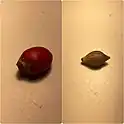| Pinang yaki | |
|---|---|
_001.jpg.webp) | |
| Fruiting specimen | |
| Scientific classification | |
| Kingdom: | Plantae |
| Clade: | Tracheophytes |
| Clade: | Angiosperms |
| Clade: | Monocots |
| Clade: | Commelinids |
| Order: | Arecales |
| Family: | Arecaceae |
| Genus: | Areca |
| Species: | A. vestiaria |
| Binomial name | |
| Areca vestiaria Giseke | |

Areca vestiaria - Trunks. January 2020. Location CAS Xishuangbanna Tropical Plant Garden, Mengla, Yunnan, SW China.
Areca vestiaria (pinang yaki or pinang merah) is a species of palm native to the rainforests of eastern Indonesia[1] especially North Sulawesi.[2] Its morphology is more diverse than other species of palms, and in particular the color of its upper trunk / crownshaft changes depending on altitude (varying between red and orange).[1]
The people of Sulawesi, near Bogani Nani Wartabone National Park, have long used the fruit of this palm as a male contraceptive.[3] They drink a decoction of the fruit flesh boiled in water.[3] The chemical composition of the fruit has been investigated with this in mind,[3] but this does not represent evidence of its effectiveness as an antifertility agent.

A. vestiaria Fruit (Left) & Seed (Right)
References
- 1 2 "Areca vestiaria - Palmpedia - Palm Grower's Guide". www.palmpedia.net. Retrieved 2017-11-26.
- ↑ "Areca vestiaria - Pacsoa". www.pacsoa.org.au. Retrieved 2017-11-26.
- 1 2 3 Simbala, Herny (September 2017). "Bioactive compounds in Pinang Yaki (Areca vestiaria) fruit as potential source of antifertility agent". Pakistan Journal of Pharmaceutical Sciences. 30 (5(Supplementary)): 1929–1937. PMID 29105623 – via ResearchGate.
This article is issued from Wikipedia. The text is licensed under Creative Commons - Attribution - Sharealike. Additional terms may apply for the media files.